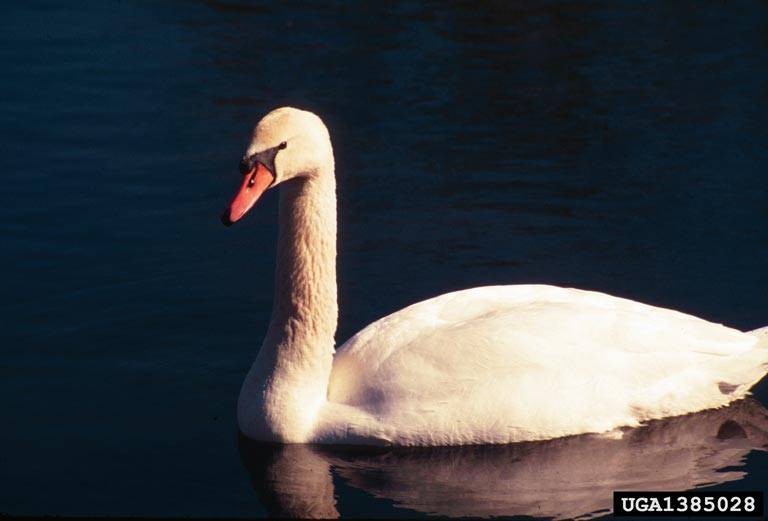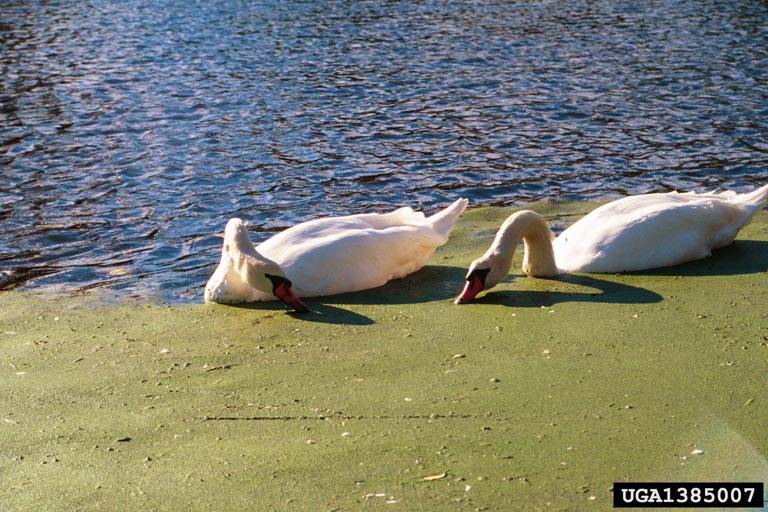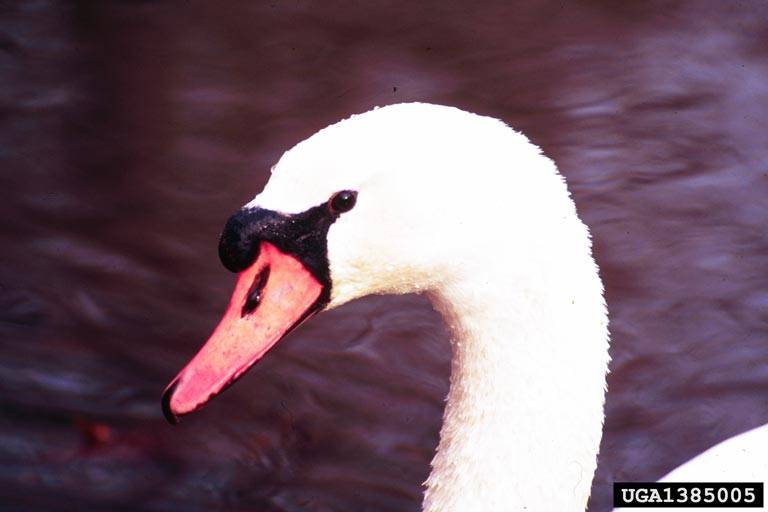Origin | Habitat | Introduction and Spread | Impacts | Identification | Prevention and Control | Occurrences | New York Distribution Map
Background
Mute swans (Cygnus olor) are non-migratory waterfowl. They were first introduced in the United States in the 1870s as a decorative, captive waterfowl because of their impressive appearance. In the early 1900s, some swans escaped captivity in New Jersey (1916) and in New York (1919). Mute swans are now found throughout the Atlantic Flyway. These birds are very aggressive and threaten many native waterfowl species.

Origin
Mute swans are native to Europe and parts of Asia.
Habitat
Mute swans thrive in aquatic habitats including bays, rivers, wetlands, lake inlets, and ponds where there is ample emergent and submerged vegetation. The swans utilize dense phragmites and cattail stands for nesting areas. A mated pair of mute swans typically stays in the same territory year-round, moving only for food shortages or if their habitat ices over.
Introduction and Spread
The swans were first brought to the United States and used in zoos and private estates because of their flashy appearance. A small number of birds escaped into the wild in New Jersey (1916) and New York (1919) and successfully created wild breeding populations. The birds then expanded into Rhode Island in the 1920s and are now found from southern Ontario, Canada to North Carolina. The release in the 1910s started with a wild population of about 500 birds. The population of mute swans in New York has increased in size to about 3000 birds.
The swans are capable of reproducing between the ages of two and five years old. They build large nests (4 – 5 feet in diameter) in March or April. Mute swans produce on average 6 eggs per clutch, but could produce as many as 11 per clutch. The eggs hatch in early June, approximately 35 days after being laid.
Impacts
Mute swans pose a threat to aquatic plant communities and other organisms that rely on the vegetation to survive. Swans can reach vegetation up to 4 feet deep. In the Chesapeake Bay, it is estimated that 4,000 swans could consume 12% of the aquatic vegetation each year (Avery and Tillman 2005). Aquatic plants found both above and below the water’s surface are affected by mute swans with the majority of damage occurring below the water’s surface (Stafford et al. 2012). Flocks of mute swans cause considerably more damage than those found in pairs (Tatu et al. 2007). Additionally, vertebrate and invertebrate species that rely on the vegetation cover are indirectly negatively impacted by mute swans. Ecosystems are under greater pressure from mute swans than from native migratory tundra swans (Cygnus columbianus) because the mute swans do not migrate and may be present year-round at the same location.
Some mute swans are very aggressive and territorial and will chase off and sometimes kill other waterfowl species that enter their territory. With the swan’s large breeding territories in wetlands, they displace many native birds for breeding habitat. Swans tend to be most aggressive during the nesting and brood-rearing stages.

Identification
An adult mute swan is all white with an orange bill and black face with a black, fleshy knob on the forehead just above the nares. It is a large waterfowl that has a long, curved neck. Juvenile mute swans have dirty gray to white bodies, gray to pink legs, and a tan to pinkish bill. Adult mute swans weigh on average 25 lbs. The adults of native trumpeter and tundra swans have a similar body shape as mute swans, but may vary in overall size, facial markings and bill color. For more information about mute swans visit:
https://www.allaboutbirds.org/guide/Mute_Swan/overview
http://www.trumpeterswansociety.org/docs/TTSS%20Swan%20Goose%20IDcolor.pdf

Prevention and Control
The New York State Department of Environmental Conservation (DEC) conducts surveys and research to gain more information on nest distributions, clutch sizes, hatching and survival rates, and numbers of breeding birds in a population. Understanding more about the population dynamics and behavior of mute swans will help for developing efficient management strategies. If a collared mute swan is found in New York, report it to the DEC to help with their tracking efforts. (For more information visit: http://www.dec.ny.gov/animals/7076.html)
In many states, egg addling, culling, and euthanasia have been performed to control mute swan populations. However, mute swans are protected by the New York State Environmental Conservation Law. Do not handle or harm the swans, their nests, or any eggs without DEC authorization. If you have a problem with controlling mute swans, contact the DEC for more information.
Occurrences
Mute swans are currently found from Ontario, Canada to North Carolina, throughout the Atlantic Flyway region. In New York State, Long Island and the Hudson Valley have the highest population of mute swans. Areas around Lake Ontario have been increasing in population size as well.
New York Distribution Map
This map shows confirmed observations (green points) submitted to the NYS Invasive Species Database. Absence of data does not necessarily mean absence of the species at that site, but that it has not been reported there. For more information, please visit iMapInvasives.



